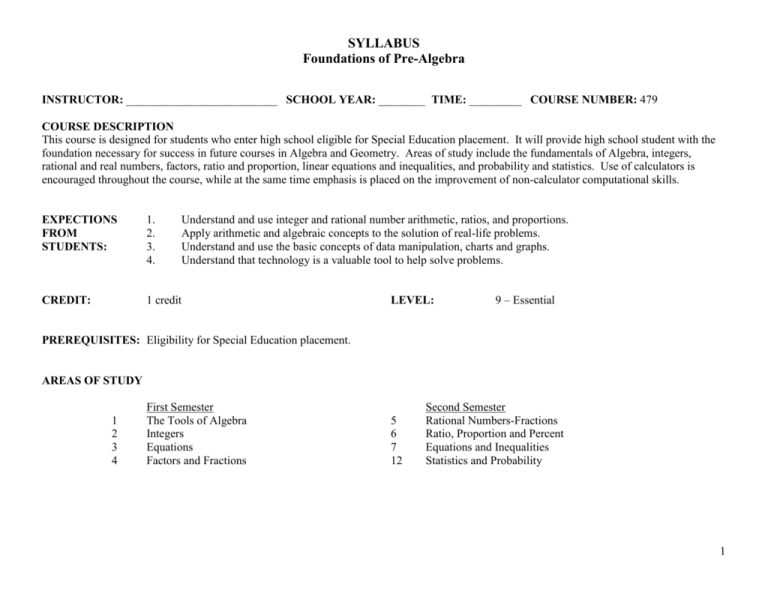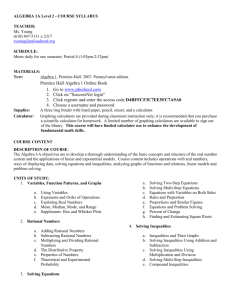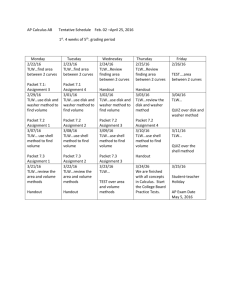Foundations of Pre-Algebra - Bremen High School District 228
advertisement

SYLLABUS Foundations of Pre-Algebra INSTRUCTOR: __________________________ SCHOOL YEAR: ________ TIME: _________ COURSE NUMBER: 479 COURSE DESCRIPTION This course is designed for students who enter high school eligible for Special Education placement. It will provide high school student with the foundation necessary for success in future courses in Algebra and Geometry. Areas of study include the fundamentals of Algebra, integers, rational and real numbers, factors, ratio and proportion, linear equations and inequalities, and probability and statistics. Use of calculators is encouraged throughout the course, while at the same time emphasis is placed on the improvement of non-calculator computational skills. EXPECTIONS FROM STUDENTS: 1. 2. 3. 4. Understand and use integer and rational number arithmetic, ratios, and proportions. Apply arithmetic and algebraic concepts to the solution of real-life problems. Understand and use the basic concepts of data manipulation, charts and graphs. Understand that technology is a valuable tool to help solve problems. CREDIT: 1 credit LEVEL: 9 – Essential PREREQUISITES: Eligibility for Special Education placement. AREAS OF STUDY 1 2 3 4 First Semester The Tools of Algebra Integers Equations Factors and Fractions 5 6 7 12 Second Semester Rational Numbers-Fractions Ratio, Proportion and Percent Equations and Inequalities Statistics and Probability 1 TIMELINES Foundations of Pre-Algebra First Semester Suggested Timelines Chapter 1 1.1 1.2 1.3 1.5 Chapter 4 15 days 4.1 4.2 4.3 4.4 4.5 4.8 Integers Factors and Fractions 15 days Factors and Monomials Powers and Exponents Prime Factorization Greatest Common Factor Simplifying Algebraic Fractions Scientific Notation Integers and Absolute Value Adding Integers Subtracting Integers Multiplying Integers Dividing Integers Squares and Square Roots Ordered Pairs and Relations The Coordinate System Chapter 3 3.1 3.2 3.3 3.4 3.5 3.6 3.7 13 days Using a Problem Solving Plan Numbers and Expressions Variables and Expressions Variables and Equations Chapter 2 2.1 2.2 2.3 2.4 2.5 9.1 1.6 2.6 The Tools of Algebra Suggested Timelines Equations The Distributive Property Simplifying Algebraic Expressions Solving Equations by Adding or Subtracting Solving Equations by Multiplying or Dividing Solving Two-Step Equations Writing Two-Step Equations Using Formulas 14 days Successmaker Training Days Number of Teaching Days Review for Semester Exam Miscellaneous Days: School Improvement, Assembly, Institute, Stand. Testing 13 days 56 days 4 days 7 days ______ 2 TIMELINES Foundations of Pre-Algebra Second Semester Chapter 5 Rational Numbers Suggested Timelines 19 days Suggested Timelines Chapter 12 5.1 5.2 5.3 5.4 5.5 5.6 5.7 5.9 Writing Fractions as Decimals Rational Numbers Multiplying Rational Numbers Dividing Rational Numbers Adding and Subtracting Like Fractions Least Common Multiple Adding and Subtracting Unlike Fractions Solving Equations with Rational Numbers Chapter 6 6.1 6.2 6.3 6.4 6.5 6.7 Equations and Inequalities Solving Equations with Variables on Each Side Solving Equations with Grouping Symbols Inequalities Solving Inequalities by Adding or Subtracting Solving Inequalities by Multiplying or Dividing 13 days Measures of Central Tendency Probability and Predictions Scatter Plots Stem-and-Leaf Plots Measures of Variations Histograms Misleading Statistics Odds 17 days Ratios and Rates Using Proportions Scale Drawings and Models Fractions, Decimals, and Percents Using the Percent Proportion Using Percent Equations Chapter 7 7.1 7.2 7.3 7.4 7.5 Ratio, Proportion, and Percent 5.8 6.8 1.7 12.1 12.2 12.4 12.5 12.8 More Statistics and Probability Optional Chapter 8-Slope Estimating Percent Mentally Perimeter and Area of Rectangles Area of Parallelograms and Triangles Pythagorean Theorem Area of Circles and Circumference Box and Whisker Plots 13 days Successmaker Training Number of Teaching Days Review for Semester Exam Miscellaneous Days: School Improvement, Assembly, Institute, Stand. Testing Review, Stand. Testing 16 days 62 days 5 days 10 days ______ 3 MATHEMATICS DEPARTMENT CURRICULUM PreAlgebra GENERAL OUTCOMES: NUMBER SENSE 5.2.1.1 TLW use and apply the concepts of arithmetic, order of operations, properties of real numbers, signed numbers, exponential & scientific notation. 5.2.2.1 TLW use and apply the concepts of ratios, proportions, percents and dimensional analysis. 5.2.3.1 TLW compute using multiple approaches, estimation, approximations, and exact values. 5.2.4.1 TLW use arithmetic to solve real-life problems. MEASUREMENT 5.3.1.1 TLW perform actual, estimated and computed measurements including angles, complementary and supplementary. 5.3.2.2 TLW understand, make, and use scale drawings, maps, globes, and blueprints. 5.3.3.1 TLW use formulas such as Pythagoras, area, perimeter, volume and conversions within a measurement system. ALGEBRA 5.4.1.1 5.4.2.1 5.4.3.2 5.7.1.1 DATA 5.6.1.1 5.6.2.1 5.6.3.1 TLW describe mathematical relationships and patterns, simplify expressions, and use order of operations as it applies to Algebra. TLW use and apply multiple representations of algebraic functions. TLW use and apply linear and quadratic equations, inequalities and systems of equations. TLW apply algebraic concepts and procedures to the solution of application problems from consumer situations. TLW construct, analyze and/or draw conclusions. TLW apply concepts of statistics including mean, median, mode, range, variance and standard deviation to solution or theoretical and/or real-life problems. TLW apply concepts of probability to solve theoretical and/or real-life problems. WRITTEN: UPDATED: TEXTBOOK: Summer, 2003 Summer, 2010 Pre-Algebra, Glencoe, 2003 BY: BY: K Carlsen, J Canning, G Charnley 4











